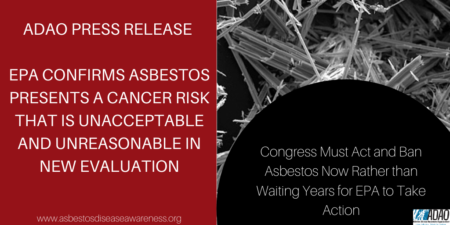FOR IMMEDIATE RELEASE
March 31, 2020
EPA CONFIRMS ASBESTOS PRESENTS A CANCER RISK THAT IS UNACCEPTABLE AND UNREASONABLE IN NEW EVALUATION
Congress Must Act and Ban Asbestos Now Rather than Waiting Years for EPA to Take Action
 WASHINGTON, DC—Yesterday the Environment Protection Agency (EPA) released the draft risk evaluation of asbestos mandated under the Toxic Substance Control Act (TSCA) which found all ongoing commercial and consumer uses of asbestos reviewed by the Agency present a cancer risk that is unreasonable under TSCA.
WASHINGTON, DC—Yesterday the Environment Protection Agency (EPA) released the draft risk evaluation of asbestos mandated under the Toxic Substance Control Act (TSCA) which found all ongoing commercial and consumer uses of asbestos reviewed by the Agency present a cancer risk that is unreasonable under TSCA.
This includes asbestos-containing diaphragms, asbestos-containing sheet gaskets, asbestos-containing brake blocks, aftermarket asbestos-containing brakes/linings, other vehicle friction products, and other asbestos-containing gaskets.
The unreasonable risk findings apply to the chlor-alkali industry, the one remaining importer of asbestos in the United States, which has argued for decades that its use of asbestos is safe.
“That EPA found this level of risk, despite the severe limitations and deficiencies of their evaluation, speaks volumes,” said Linda Reinstein, president and co-founder of the Asbestos Disease Awareness Organization (ADAO). “We have repeatedly noted their flawed approach fails to fully recognize and evaluate the public health threat of asbestos. That is why Americans can’t wait for the EPA to get it right. We need Congress to move to now to pass the Alan Reinstein Ban Asbestos Now Act which would ban imports, use, and mitigate asbestos in our homes, schools, and workplaces.”
The flaws in the EPA evaluation include the following:
- The evaluation only examines one type of asbestos fiber — chrysotile — even though there are six recognized asbestos fibers.
- EPA only looks at the risks of lung cancer and mesothelioma. It does not consider other types of cancer (ovarian and laryngeal) that are known to be caused by asbestos or serious non-cancer diseases (asbestosis) related to asbestos exposure.
- As EPA acknowledges, it lacks basic information about ongoing asbestos uses, including the quantities involved, the nature of the use and the number of workers and consumers exposed.
- In addition, known asbestos-containing products (such as fabric and cement), previously identified in import records or trade literature, are ignored. An example is the documented presence of asbestos in crayons and other common consumer products to which infants and children are exposed.
Had EPA granted the petitions of ADAO and 18 State Attorneys General to require reporting on asbestos under TSCA, EPA would have been able to collect this missing information and its evaluation would not contain these fundamental data gaps.
Further, within this limited evaluation EPA did not examine environmental sources of exposure to asbestos which contribute to risks to millions of Americans, including consumers and workers already exposed to asbestos in their homes and workplaces.
The draft evaluation does not address the risks of legacy asbestos products contained in millions of buildings across the US, despite a ruling from the Ninth Circuit Court of Appeals last year that EPA is obligated to evaluate these risks. While EPA makes vague promises to conduct a supplemental evaluation of legacy asbestos products, no process or timetable for meeting this obligation is provided.
Finally, EPA erroneously concludes that importation and distribution in commerce of asbestos and asbestos-containing products do not present an unreasonable risk of injury.
Although EPA’s evaluation fails to include many exposures to asbestos and understates the risks of those uses it addresses, it still demonstrates yet again the extreme dangers of asbestos and the severe threat of death and serious disease it continues to pose to Americans. Had EPA undertaken the comprehensive risk evaluation its own experts and public health advocates urged them to take, they would have certainly found asbestos presents an even greater risk to public health, as ADAO and others have repeatedly said.
Since its asbestos ban was overturned by the courts in 1991, EPA has taken virtually no action on asbestos while thousands more Americans have become sick and died from asbestos-related illnesses and diseases. The next steps under TSCA will take years to complete and there’s no assurance that EPA will ultimately take strong and comprehensive action.
For that reason, ADAO has called on Congress to act. Each year, more than 40,000 Americans died from asbestos-caused diseases, yet imports and use continue. More than 70 countries around the world have already banned asbestos. Congress must do the same. The bipartisan, bicameral Alan Reinstein Ban Asbestos Now Act would ban asbestos use and imports in the United States. It is currently awaiting a vote by the full House of Representatives Every day of inaction further endangers public health and safety. There is no time to waste. We urge Congress to pass ARBAN now.
###
Media Contacts
Tracy Russo, (202) 556-1631
tracy@upshiftstrategies.com
Courtney Hightower, (312) 213-7245
courtney@upshiftstrategies.com
About the Asbestos Disease Awareness Organization
The Asbestos Disease Awareness Organization (ADAO) was founded by asbestos victims and their families in 2004. ADAO is the largest non-profit in the U.S. dedicated to providing asbestos victims and concerned citizens with a united voice through our education, advocacy, and community initiatives. ADAO seeks to raise public awareness about the dangers of asbestos exposure, advocate for an asbestos ban, and protect asbestos victims’ civil rights. For more information, visit www.asbestosdiseaseawareness.org.
